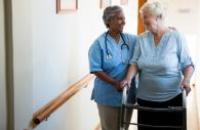National Healthcare Quality and Disparities Report
Latest available findings on quality of and access to health care
Data & Analytics
- Data Infographics
- Data Visualizations
- Data Tools
- Data Innovations
- All-Payer Claims Database
- Consumer Assessment of Healthcare Providers and Systems (CAHPS®) Program
- Healthcare Cost and Utilization Project (HCUP)
- Medical Expenditure Panel Survey (MEPS)
- National Healthcare Quality and Disparities Report Data Tools
- Network of Patient Safety Databases
- AHRQ Quality Indicator Tools for Data Analytics
- Surveys on Patient Safety Culture
- United States Health Information Knowledgebase (USHIK)
- Data Sources Available from AHRQ
Topics
Information on AHRQ's most-searched topics are included below and in the A to Z menu above.
Results
Topics 11 - 20 of 20 displayed
Each year, somewhere between 700,000 and 1,000,000 people in the United States fall in the hospital, and about 1.3 million residents in nursing facilities fall. Falls can lead to serious injuries, decreased ability to function, reduced quality of life, increased fear of falling, and increased health care use. AHRQ’s tools, training, and research on preventing falls in hospitals and nursing homes.
Health literacy occurs when health information and services created for the public match with people's capacity to find, understand, and use them. AHRQ's health literacy resources help health care professionals and delivery organizations make information easier to understand and systems easier to navigate for patients.
Reducing preventable hospital readmissions is a national priority for payers, providers, and policymakers seeking to improve health care and lower costs. In 2012, the Centers for Medicare & Medicaid Services began reducing Medicare payments for certain hospitals with excess 30-day readmissions for patients with several conditions. AHRQ’s tools, data, and research to help hospitals reduce preventable readmissions.
The AHRQ Policy on the Inclusion of Priority Populations in Research (NOT-HS-03-010) requires that priority populations be included in all AHRQ-supported research projects involving human subjects, unless a clear and compelling rationale and justification is provided that inclusion is inappropriate. Research on priority populations has been emphasized and encouraged by AHRQ, but research results lag in their ability to identify evidence-based solutions to improving healthcare safety, quality, efficiency and effectiveness. AHRQ's priority populations, specified by Congress in the Healthcare Research and Quality Act of 1999 (Public Law 106-129) include: women, children, racial and ethnic minorities, populations with special healthcare needs (chronic illness, disabilities, and end of life care needs), the elderly, low-income, inner-city, and rural populations.
A set of behaviors by patients, family members, and health professionals and a set of organizational policies and procedures that foster both the inclusion of patients and family members as active members of the health care team and collaborative partnerships with providers and provider organizations.
AHRQ has information on the National Quality Strategy, data on health care quality, details on quality measurement projects, and AHRQ resources on quality.
AHRQ’s Surveys on Patient Safety Culture (SOPS™) Program, develops and maintains surveys, toolkits, and databases on patient safety culture for hospitals, medical offices, nursing homes, community pharmacies, and ambulatory surgery centers.
AHRQ has invested in research and shared information on the benefits of telehealth for several years, through its Digital Healthcare Research Program and Effective Healthcare Program.
AHRQ’s tools and research to ensure safe and seamless transitions of patients from one care setting to another, reducing preventable adverse events, drug-related errors, and other problems.













